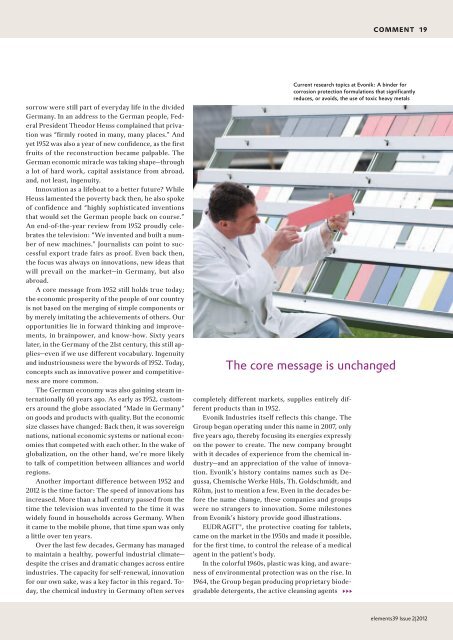Download - Evonik Industries
Download - Evonik Industries
Download - Evonik Industries
Create successful ePaper yourself
Turn your PDF publications into a flip-book with our unique Google optimized e-Paper software.
sorrow were still part of everyday life in the divided<br />
Germany. In an address to the German people, Federal<br />
President Theodor Heuss complained that privation<br />
was “firmly rooted in many, many places.” And<br />
yet 1952 was also a year of new confidence, as the first<br />
fruits of the reconstruction became palpable. The<br />
German economic miracle was taking shape—through<br />
a lot of hard work, capital assistance from abroad,<br />
and, not least, inge nuity.<br />
Innovation as a lifeboat to a better future? While<br />
Heuss lamented the poverty back then, he also spoke<br />
of confidence and “highly sophisticated inventions<br />
that would set the German people back on course.”<br />
An end-of-the-year review from 1952 proudly celebrates<br />
the television: “We invented and built a number<br />
of new machines.” Journalists can point to successful<br />
export trade fairs as proof. Even back then,<br />
the focus was always on innovations, new ideas that<br />
will prevail on the market—in Germany, but also<br />
abroad.<br />
A core message from 1952 still holds true today;<br />
the economic prosperity of the people of our country<br />
is not based on the merging of simple components or<br />
by merely imitating the achievements of others. Our<br />
opportunities lie in forward thinking and improvements,<br />
in brainpower, and know-how. Sixty years<br />
later, in the Germany of the 21st century, this still applies—even<br />
if we use different vocabulary. Ingenuity<br />
and industriousness were the bywords of 1952. Today,<br />
concepts such as innovative power and competitiveness<br />
are more common.<br />
The German economy was also gaining steam internationally<br />
60 years ago. As early as 1952, customers<br />
around the globe associated “Made in Germany”<br />
on goods and products with quality. But the economic<br />
size classes have changed: Back then, it was sovereign<br />
nations, national economic systems or national economies<br />
that competed with each other. In the wake of<br />
globalization, on the other hand, we’re more likely<br />
to talk of competition between alliances and world<br />
regions.<br />
Another important difference between 1952 and<br />
2012 is the time factor: The speed of innovations has<br />
increased. More than a half century passed from the<br />
time the television was invented to the time it was<br />
widely found in households across Germany. When<br />
it came to the mobile phone, that time span was only<br />
a little over ten years.<br />
Over the last few decades, Germany has managed<br />
to maintain a healthy, powerful industrial climate—<br />
despite the crises and dramatic changes across entire<br />
industries. The capacity for self-renewal, innovation<br />
for our own sake, was a key factor in this regard. Today,<br />
the chemical industry in Germany often serves<br />
completely different markets, supplies entirely different<br />
products than in 1952.<br />
<strong>Evonik</strong> <strong>Industries</strong> itself reflects this change. The<br />
Group began operating under this name in 2007, only<br />
five years ago, thereby focusing its energies expressly<br />
on the power to create. The new company brought<br />
with it decades of experience from the chemical industry—and<br />
an appreciation of the value of innovation.<br />
<strong>Evonik</strong>’s history contains names such as Degussa,<br />
Chemische Werke Hüls, Th. Goldschmidt, and<br />
Röhm, just to mention a few. Even in the decades before<br />
the name change, these companies and groups<br />
were no strangers to innovation. Some milestones<br />
from <strong>Evonik</strong>’s history provide good illustrations.<br />
EUDRAGIT®, the protective coating for tablets,<br />
came on the market in the 1950s and made it possible,<br />
for the first time, to control the release of a medical<br />
agent in the patient’s body.<br />
In the colorful 1960s, plastic was king, and awareness<br />
of environmental protection was on the rise. In<br />
1964, the Group began producing proprietary biodegradable<br />
detergents, the active cleansing agents 333<br />
CoMMent<br />
Current research topics at evonik: A binder for<br />
corrosion protection formulations that significantly<br />
reduces, or avoids, the use of toxic heavy metals<br />
The core message is unchanged<br />
19<br />
elements39 Issue 2|2012
















